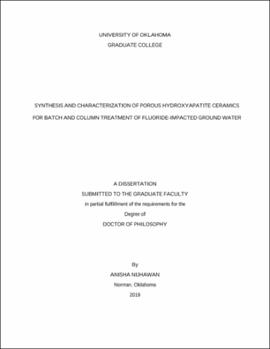| dc.contributor.advisor | Sabatini, David | |
| dc.contributor.author | Nijhawan, Anisha | |
| dc.date.accessioned | 2019-05-07T13:51:42Z | |
| dc.date.available | 2019-05-07T13:51:42Z | |
| dc.date.issued | 2019-05-10 | |
| dc.identifier.uri | https://hdl.handle.net/11244/319568 | |
| dc.description.abstract | Nearly 200 million people worldwide are exposed to drinking water with elevated levels of naturally occurring fluoride. The World Health Organization recommends a maximum fluoride concentration of 1.5 mg/L in drinking water above which it can cause dental fluorosis and skeletal fluorosis. This research focused on developing a low-cost adsorbent to overcome the limitations of existing fluoride removal materials.
Porous hydroxyapatite ceramic adsorbents were synthesized and characterized to study the effect of size of hydroxyapatite grains, pore size and pore volume on fluoride removal. The maximum fluoride adsorption capacity, determined by fitting isotherm data to Langmuir parameters, was 18 mg/g which is 3 to 4 times higher than widely used adsorbents such as activated alumina and bone char. This ceramic adsorbent was regenerated with 1 M NaOH and retained 70% of its original adsorption capacity for up to 4 adsorption cycles. Further, it had good selectivity for fluoride; of several ions evaluated, only chloride competed for adsorbent sites at concentrations commonly found in groundwater.
The kinetic performance of this adsorbent was tested through batch kinetic tests and continuous-flow columns studies. Equilibrium fluoride concentration and time to reach equilibrium were found to be independent of adsorbent size, suggesting that the effective intraparticle diffusivity is independent of adsorbent size. Continuous-flow columns studies revealed that the breakthrough curves, plotting the effluent fluoride concentration versus number of bed volumes treated, were dependent on flow rate. Interrupting the column flow led to a decrease in effluent concentration suggesting that mass transport was limited by intraparticle diffusion i.e. diffusion of fluoride ions into the pores and along the surface of the pores inside the porous ceramic.
On a bed volume basis, the ceramic performed six to seven times better than activated alumina and bone char. The cost of manufacturing this media was found to be approximately $1.6 per kg, estimated from bulk raw material costs and electricity consumption, which is comparable to the cost of commercially available activated alumina, demonstrating that this material has the potential to be cost-effective in resource-limited settings. | en_US |
| dc.language | en_US | en_US |
| dc.subject | batch adsorption | en_US |
| dc.subject | column studies | en_US |
| dc.subject | fluoride removal | en_US |
| dc.subject | low-cost hydroxyapatite ceramics | en_US |
| dc.title | Synthesis and Characterization of Porous Hydroxyapatite Ceramics for Batch and Column Treatment of Fluoride-Impacted Ground Water | en_US |
| dc.contributor.committeeMember | Butler, Elizabeth C. | |
| dc.contributor.committeeMember | Nairn, Robert | |
| dc.contributor.committeeMember | Chamberlain, Jim | |
| dc.contributor.committeeMember | Ziolkowska, Jadwiga | |
| dc.date.manuscript | 2019-05-03 | |
| dc.thesis.degree | Ph.D. | en_US |
| ou.group | Gallogly College of Engineering::School of Civil Engineering and Environmental Science | en_US |
| shareok.nativefileaccess | restricted | en_US |
